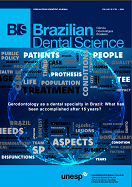Endocrown: a conservative approach
DOI:
https://doi.org/10.14295/bds.2016.v19i2.1156Abstract
ABSTRACT
The purpose of this clinical case description article was to present the planning sequence, indication, treatment and performance to obtain a crown of the Endocrown type. This clinical case description article illustrates a therapeutic option for functional and esthetic rehabilitation of a devitalized mandibular molar, presenting a small amount of remaining coronal tooth structure, by means of cementing a pure porcelain crown of the Endocrown type (Adhesive Endodontic Crown). A 39-year-old woman presented to the Graduate clinic of the Bauru Dental School (FOB), University of São Paulo (USP), with the complaint that tooth #36 had an extensive and unsatisfactory composite resin restoration. The lithium disilicate-based system of monolithic porcelain was used with the lost wax technique. This therapy promoted the stability and retention of the indirect restoration, without the need for performing reconstruction of the above mentioned tooth, either by means of a cast metal core or reconstruction with intracanal post, thereby reducing the treatment time. After the tooth preparation, the provisional restoration was done with acrylic resin to determine if the retention and stability of the remaining tooth was adequate to receive the indirect Endocrown restoration. The characteristics of the internal and external walls of the dental remnants, cervical termination, impression-taking, laboratory stages and adhesive cementation will be discussed. The major advantage of indicating an endocrown is the use of the dental remnants itself, particularly the pulp chamber, to promote retention and stability in cases without adequate height for performing complete dental and crown reconstruction.
Keywords
Adhesive endodontic crown; Devitalized tooth; Lithium dissilicate.
Downloads
Downloads
Additional Files
Published
How to Cite
Issue
Section
License
Brazilian Dental Science uses the Creative Commons (CC-BY 4.0) license, thus preserving the integrity of articles in an open access environment. The journal allows the author to retain publishing rights without restrictions.
=================




























